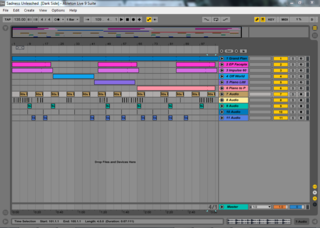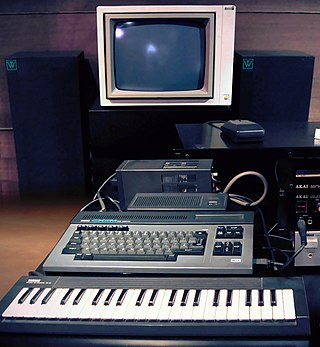Related Research Articles

An electronic musical instrument or electrophone is a musical instrument that produces sound using electronic circuitry. Such an instrument sounds by outputting an electrical, electronic or digital audio signal that ultimately is plugged into a power amplifier which drives a loudspeaker, creating the sound heard by the performer and listener.

Roland Corporation is a Japanese manufacturer of electronic musical instruments, electronic equipment, and software. It was founded by Ikutaro Kakehashi in Osaka on 18 April 1972. In 2005, its headquarters relocated to Hamamatsu in Shizuoka Prefecture. It has factories in Malaysia, Taiwan, Japan, and the United States. As of 31 March 2010, it employed 2,699 people. In 2014, it was subject to a management buyout by its CEO, Junichi Miki, supported by Taiyo Pacific Partners.

Digital music technology encompasses digital instruments, computers, electronic effects units, software, or digital audio equipment by a performer, composer, sound engineer, DJ, or record producer to produce, perform or record music. The term refers to electronic devices, instruments, computer hardware, and software used in performance, playback, recording, composition, mixing, analysis, and editing of music.

FL Studio is a digital audio workstation (DAW) developed by the Belgian company Image-Line. It features a graphical user interface with a pattern-based music sequencer. The program is available in four different editions for Microsoft Windows and macOS.
Steinberg Media Technologies GmbH is a German musical software and hardware company based in Hamburg. It develops music writing, recording, arranging, and editing software, most notably Cubase, Nuendo, and Dorico. It also designs audio and MIDI hardware interfaces, controllers, and iOS/Android music apps including Cubasis. Steinberg created several industry standard music technologies including the Virtual Studio Technology (VST) format for plug-ins and the ASIO protocol. Steinberg has been a wholly owned subsidiary of Yamaha since 2005.

Virtual Studio Technology (VST) is an audio plug-in software interface that integrates software synthesizers and effects units into digital audio workstations. VST and similar technologies use digital signal processing to simulate traditional recording studio hardware in software. Thousands of plugins exist, both commercial and freeware, and many audio applications support VST under license from its creator, Steinberg.

A digital audio workstation (DAW) is an electronic device or application software used for recording, editing and producing audio files. DAWs come in a wide variety of configurations from a single software program on a laptop, to an integrated stand-alone unit, all the way to a highly complex configuration of numerous components controlled by a central computer. Regardless of configuration, modern DAWs have a central interface that allows the user to alter and mix multiple recordings and tracks into a final produced piece.

Novation Digital Music Systems Ltd. is a British musical equipment manufacturer, founded in 1992 by Ian Jannaway and Mark Thompson as Novation Electronic Music Systems. Today the company specializes in MIDI controllers with and without keyboards, both analog and virtual analog performance synthesizers, grid-based performance controllers, and audio interfaces. At present, Novation products are primarily manufactured in China.

Ableton Live, also known as Live, is a digital audio workstation for macOS and Windows developed by the German company Ableton.
A rompler is an electronic musical instrument that plays pre-fabricated sounds based on audio samples. The term rompler is a blend of the terms ROM and sampler. In contrast to samplers, romplers do not record audio. Both may have additional sound editing features, such as layering several waveforms and modulation with ADSR envelopes, filters and LFOs.
The Yamaha TX81Z is a rack version of Yamaha DX11 and rack-mounted (keyboard-less) frequency modulation music synthesizer, which was released in 1987. Unlike previous FM synthesizers of the era, the TX81Z was the first to offer a range of oscillator waveforms other than just sine waves, conferring the new timbres of some of its patches when compared to older, sine-only FM synths. The TX81Z has developed a famous reputation, largely based on some of its preset bass sounds. A keyboard version with more onboard editing abilities was released the following year as the Yamaha DX11.

The RolandJuno-60 is an analog synthesizer manufactured by the Roland Corporation between 1982 and 1984. It followed the Juno-6, an almost identical synthesizer released months earlier. The Juno synthesizers introduced Roland's digitally controlled oscillators, allowing for greatly improved tuning stability over its competitors.
Synapse Audio Software is a software company located in Germany. Previously known as Sonic Syndicate and headed by Richard Hoffmann, they develop music production software for the Mac OS and Microsoft Windows platforms. They started developing software in November 1998 as Sonic Syndicate and changed their name to Synapse Audio with the release of Orion Platinum in 2002.

SynthEdit is a modular audio plugin development environment which uses a visual editor. First conceived in 1987 by programmer Jeff McClintock and initially distributed in 1999, it was officially released in 2005.

LMMS is a digital audio workstation application program. It allows music to be produced by arranging samples, synthesizing sounds, entering notes via mouse or by playing on a MIDI keyboard, and combining the features of trackers and sequencers. It is free and open source software, written in Qt and released under GPL-2.0-or-later.

A synthesizer is an electronic musical instrument that generates audio signals. Synthesizers typically create sounds by generating waveforms through methods including subtractive synthesis, additive synthesis and frequency modulation synthesis. These sounds may be altered by components such as filters, which cut or boost frequencies; envelopes, which control articulation, or how notes begin and end; and low-frequency oscillators, which modulate parameters such as pitch, volume, or filter characteristics affecting timbre. Synthesizers are typically played with keyboards or controlled by sequencers, software or other instruments and may be synchronized to other equipment via MIDI.

Yamaha CX5M is an MSX-system compatible computer that expands upon the normal features expected from these systems with a built-in eight-voice FM synthesizer module, introduced in 1984 by Yamaha Corporation.

Synth1 is a software synthesizer designed by KVR user Daichi. It was originally designed as an emulation of the Nord Lead 2 synthesizer, and has since become a unique Virtual Studio Technology instrument and one of the most downloaded VST plug-ins of all time. The software used to be a DirectX instrument plugin, but became solely VSTi from version 1.08 on. Version 1.13 was the first version to introduce a native 64-bit version of the plugin.

The Yamaha DX21 is a digital controlled bi-timbral programmable digital FM synthesizer with a four operator synth voice generator which was released in 1985. It uses sine wave-based frequency modulation (FM) synthesis. It has two FM tone generators and a 32-voice random-access memory (RAM), 32 user voices and 128 read-only memory (ROM) factory preset sounds. As a programmable synth, it enables users to create their own unique synthesized tones and sound effects by using the algorithms and oscillators. The instrument weighs 8 kg (17.6 lbs). On its release, it sold for $795.
The Roland MKS-20 is a digital piano-type sound module released by Roland Corporation in 1986. It is a rackmount version of the popular 1980s-era Roland RD-1000 digital piano. The RD-1000 has the exact same sound engine mounted in a musical keyboard-type MIDI controller. Both use Roland's "structured adaptive synthesis approach" to provide eight keyboard sounds, including grand piano, electric piano, harpsichord, vibraphone, and clavinet. Both have three effects units built in: stereo chorus, stereo tremolo, and a three-band equalizer with a sweepable mid-range.
References
- ↑ "Yamaha Portasound keyboard advertisement (1982)". The Central New Jersey Home News. 1982-03-07. p. 188. Retrieved 2020-05-16.
- ↑ "Yamaha Portasound advertisement (1982)". Great Falls Tribune. 1982-09-05. p. 98. Retrieved 2020-05-16.
- ↑ "7 Cheap Ways to Add Unique Tones to Your Tracks". reverb.com. Retrieved 2019-12-21.
- ↑ Cohan, Brad (2015-11-21). "Dan Friel Is a DIY Renegade Here to Save Us from Ourselves". Vice. Retrieved 2019-12-21.
- ↑ "5 Excellent Electronic Albums Made With a Single Synthesizer". Pitchfork. Retrieved 2019-12-21.
- ↑ November 2013, Tony Ware 28. "Cyril Hahn talks production techniques, the influence of DIY culture and creating ambience". MusicRadar. Retrieved 2020-05-21.
- ↑ "Bobby's place". members.chello.at. Retrieved 2020-05-16.
- ↑ "Ctrlr – Control your MIDI life (MIDI editor for all your hardware)" . Retrieved 2020-05-16.
- ↑ "Yamaha PSS-170". Audio Animals Ltd. Retrieved 2020-05-16.
- ↑ "Yamaha PSS-480 - Free VST Instrument Download". Audio Animals Ltd. 2019-10-18. Retrieved 2020-05-16.
- ↑ "Download Free PSS-370 emulation plug-in: GSS-370 by SynthIV". www.vst4free.com. Retrieved 2020-05-16.
- ↑ "PortaFM - Plogue Revives The Iconic Yamaha PSS Synthesizers In A New Plugin". SYNTH ANATOMY. 2018-05-15. Retrieved 2020-05-16.
- ↑ May 2018, Ben Rogerson 16. "Get the sound of your '80s PortaSound home keyboard with Plogue's PortaFM synth plugin". MusicRadar. Retrieved 2020-05-16.